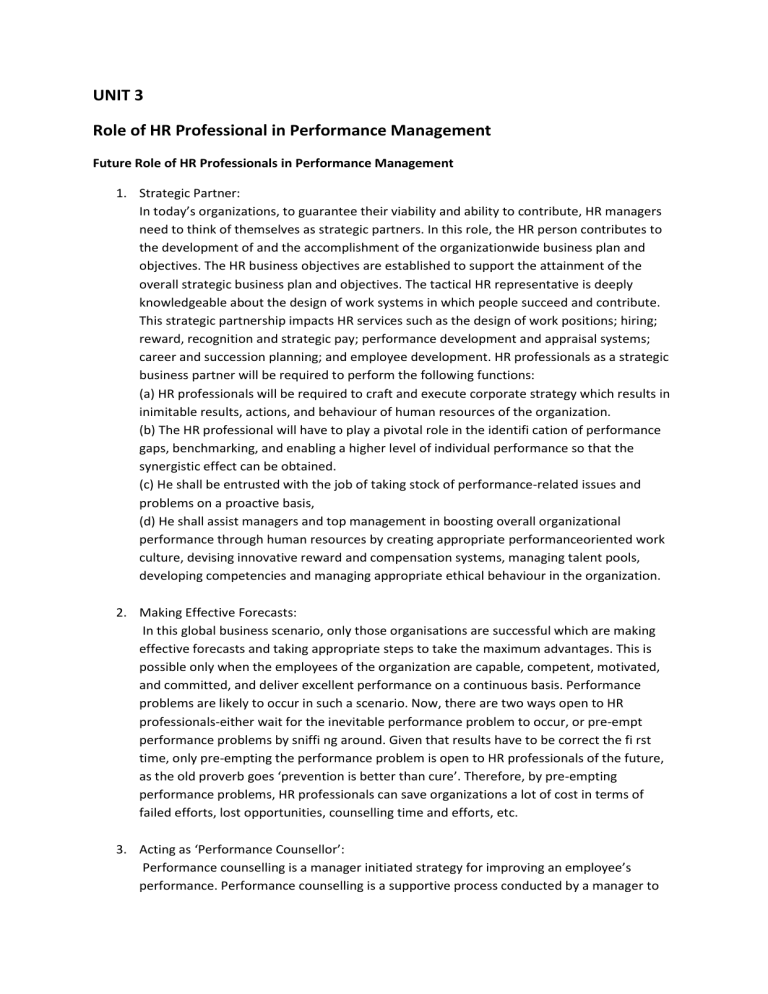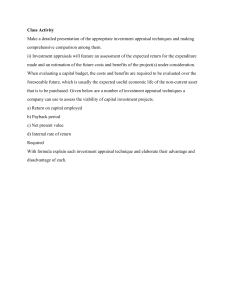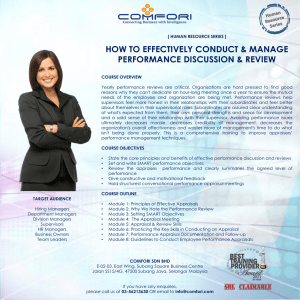
UNIT 3 Role of HR Professional in Performance Management Future Role of HR Professionals in Performance Management 1. Strategic Partner: In today’s organizations, to guarantee their viability and ability to contribute, HR managers need to think of themselves as strategic partners. In this role, the HR person contributes to the development of and the accomplishment of the organizationwide business plan and objectives. The HR business objectives are established to support the attainment of the overall strategic business plan and objectives. The tactical HR representative is deeply knowledgeable about the design of work systems in which people succeed and contribute. This strategic partnership impacts HR services such as the design of work positions; hiring; reward, recognition and strategic pay; performance development and appraisal systems; career and succession planning; and employee development. HR professionals as a strategic business partner will be required to perform the following functions: (a) HR professionals will be required to craft and execute corporate strategy which results in inimitable results, actions, and behaviour of human resources of the organization. (b) The HR professional will have to play a pivotal role in the identifi cation of performance gaps, benchmarking, and enabling a higher level of individual performance so that the synergistic effect can be obtained. (c) He shall be entrusted with the job of taking stock of performance-related issues and problems on a proactive basis, (d) He shall assist managers and top management in boosting overall organizational performance through human resources by creating appropriate performanceoriented work culture, devising innovative reward and compensation systems, managing talent pools, developing competencies and managing appropriate ethical behaviour in the organization. 2. Making Effective Forecasts: In this global business scenario, only those organisations are successful which are making effective forecasts and taking appropriate steps to take the maximum advantages. This is possible only when the employees of the organization are capable, competent, motivated, and committed, and deliver excellent performance on a continuous basis. Performance problems are likely to occur in such a scenario. Now, there are two ways open to HR professionals-either wait for the inevitable performance problem to occur, or pre-empt performance problems by sniffi ng around. Given that results have to be correct the fi rst time, only pre-empting the performance problem is open to HR professionals of the future, as the old proverb goes ‘prevention is better than cure’. Therefore, by pre-empting performance problems, HR professionals can save organizations a lot of cost in terms of failed efforts, lost opportunities, counselling time and efforts, etc. 3. Acting as ‘Performance Counsellor’: Performance counselling is a manager initiated strategy for improving an employee’s performance. Performance counselling is a supportive process conducted by a manager to enable an employee to define and work through personal problems or organizational changes that affects job performance. Because it means better bottom-line results, organizations recognize and reward such managers. Managers with good counselling skills can get that kind of performance from their employees by using the tools of counselling 4. Employee Advocate: As an employee sponsor or advocate, the HR manager plays an integral role in organizational success via his knowledge about and advocacy of people. This advocacy includes expertise in how to create a work environment in which people will choose to be motivated, contributing, and happy. Fostering effective methods of goal setting, communication and empowerment through responsibility, builds employee ownership of the organization. The HR professional helps establish the organizational culture and climate in which people have the competency, concern and commitment to serve customers well. In this role, the HR manager provides employee development opportunities, employee assistance programs, gainsharing and profit-sharing strategies, organization development interventions, due process approaches to problem solving and regularly scheduled communication opportunities. 5. Change Champion: The constant evaluation of the effectiveness of the organization results in the need for the HR professional to frequently champion change. Both knowledge about and the ability to execute successful change strategies make the HR professional exceptionally valued. Knowing how to link change to the strategic needs of the organization will minimize employee dissatisfaction and resistance to change. Appraising HR Functions Human Resources is responsible for initiating the performance appraisal process for the department to assess the performance of its staff. On top of it, Human Resources is tasked to design and develop the Performance Management System. Human Resources would need to know the business for its critical success factors. Human Resources play the role of business partner of the company. The key performance indicators (KPIs) shall derive from the business indicators. These indicators can be tangible or intangible. Few organizations meaningfully involve the HR function in formulating corporate strategy, designing offerings, and managing partnerships. The objective of the HR function is to provide a favourable and supporting climate and appropriate systems to align the human performance with business strategies of the organization. The two major crises faced by Human Resource are: 1. Identity crisis in defining its role in the organization, and 2. Accountability crisis in demonstrating the value of HR contribution in improving the organization’s performance. 1. Operations Perspective: This perspective includes the internal business processes and their alignment with HR functions. The HR function should fi nd out the key problems and their effective solution. Metrics based on this perspective allow senior leadership to know the effectiveness, effi ciency, and quality of these HR processes in meeting organizational and environmental requirements. 2. Financial Perspective: Another important HR function is to keep the cost of compensation and benefits at an optimal level. The HR professions should consider the organisation’s ability to pay and other growth perspective. The HR professional’s needs to focus on the employee’s contribution in terms of financial data with respect to investment made on employees. 3. HR Perspective: HR perspective includes employee training and corporate cultural attitudes related to both individual and corporate self-improvement. In these days the organisational success depends on how effectively the organisations are discovering and managing their human resources. The key differentiator between the successful and unsuccessful organisations is the effectiveness of knowledge-worker. Today’s HR function needs to develop an innovative workforce capable of delivering results at all times, consistently and continuously 4. Customer Perspective: The recent days the organisations have realised the importance of customers in business success. The organisational have realised that if customers are not satisfied, they will eventually find other organisations that will meet their needs. Employee Assessment system What is Employee Assessment? Employee assessments are performance appraisals or reviews used to evaluate employees' performance and productivity. These tests assess personality, aptitude and skills. Employee assessments are usually done for compensation review, performance improvement, promotions, terminations etc. How to measure employee assessments Human resource management conducts employee assessments in order to improve their performance and to monitor what the employee is doing according to what he/she is expected to do. Methods: 1. 360 degree feedback: multiple evaluation process which includes assessments from superiors, peers and ones' self 2. SWOT analysis: evaluating strengths and weaknesses of an employee 3. Performance interview: last step of the evaluation process How do you assess employee skills? 1. Give Your Employees A Test This is pretty ancient and economical thanks to assess technical and theoretical information. However, such tests square measure conducted within the “laboratory” conditions, so that they don't provide the precise image whether or not the worker are able to use the information in reality or not. Use such check, however solely often - otherwise, you would possibly be frustrated once it involves additional realistic conditions. 2. Ask To Prepare Self-Assessment You can send your personnel a questionnaire which they should fill in by themselves. On the one hand it shows not only their abilities, but also their self-perception. On the other hand, you might not benefit from such a subjective point of view in either way: Βe their evaluation too optimistic or to pessimistic. Thus, this method should be used in combination with some other, more objective one. 3. Get Feedback From The Teams There is some sound judgement in what the team members would say, however it's positive|needless to say|of course|obviously|as expected|evidently} additional objective instead of simply looking forward to the opinion of 1 person! raise staff to share their feedback on every other’s performance (make sure it doesn't go personal!) and see if every of them will do his job on a high level. 4. Put Them In Real Situations The most economical thanks to train and assess skills - nothing is higher than follow. however what if you merely cannot risk and leave the “testing” till the time comes. What if during this real time conditions, your worker fails? ready to} take up this risk? to create certain that your staff area unit able to perform the task it's safer to begin with different ways. However, if you're certain in high qualifications of your employees, you'll be able to place them in world conditions to challenge them and check their proficiency. 5. Let Them Play A Business Game Current trend of gamification penetrated varied aspects of our lives. these days not solely youngsters play the games, and plenty of games haven't solely operate of diversion, however additionally serve skilled goals and area unit created for adults. 6. Ask For Clients’ Feedback One kind of the $64000 life scenario testing. The distinction is that you just assess the actions when they need been performed. it's a decent manner not solely to visualize however your worker works, however additionally to speak with the shopper and learn additional regarding his/her wants. Use this nice chance, however certify that your employees have already got ample skills to be tested with this methodology. Role of HR in Performance Management System There have been many queries on the role of HR in Performance Management System; some members bestow correct answers to such questions being raised, this is my take on the topic: WHAT IS THE ROLE OF HR IN PERFORMANCE MANAGEMENT SYSTEM. In most organisations, senior managers and directors detest conducting performance assessments, usually because they are uncomfortable and inexperienced in conducting them. They will be typically heard saying that appraisals don’t work and are a waste of time. A similar approach then cascades down the line and fails the whole system of performance appraisal. Before we talk about the agenda here today, why not take a look at the traditional approach of HR in appraisals and then shift the discussion towards the new strategic role of HR in managing employee’s performance. Basically, traditional HR performance appraisal system weighs how well a subordinate satisfies his boss or superior during the appraisal period. This degree of satisfaction may or may not be related to how well the employee contributed to corporate goals. Most of the time, it does not. For this reason, conventional performance appraisal has become a highly politicized, controversial, biased exercise that creates more dissonance than teamwork in the organization. In contemporary epoch HR has to play a strategic role to develop capability, attitude and to initiate performance with quality into the product where the HR has to collaborate with line managers to retain employees, which automatically affects the retention of customers because it is the driving force of customers. The goal of performance appraisal is to allow an employee the opportunity to progress to their full potential in order to meet organizational needs and his/her personal development goals. Through this process, true teamwork and maximum performance can be achieved. The foundation of the performance appraisal process is an improved communication between the employee and the supervisor. The Employee Relations/employee care/ Human Capital unit is available to assist managers, supervisors, and employees in utilizing the appraisal process and resolving workplace performance issues. Due to the paradigm shift and the Gen Y joining the workforce the major concern is not the ratings and hike, now employees are more concerned about the feedback and their Individual development plans. The HR department can now share the feedback with people, both negative and positive which not only increases the communication but also builds the trust of the employee in an organisation. HR’s role in the Appraisals is not just related to the designing of the system but it has moved to a more substantial role of being a mentor, regulator and to look into the details of why a person’s performance is below par. In this new role, HR department also organizes mid term reviews to control the lows and increases the highs with timely checks on a regular basis, in fact it does not remain as a system The evaluation of one’s performance can be utilized for TNI &A, and it helps designing the career plan for the employees. Training and development are better where HR plays an important role in PMS also. Competencies That Support Effective Performance Management (SKILLS) planning work and setting expectations, monitoring and measuring performance, developing the capacity to perform, periodically rating performance in a summary fashion, and Recognizing and rewarding good performance. Practicing good performance management requires proficiency in certain competencies. Competencies are observable, measurable patterns of skills, knowledge, abilities, behaviors, and other characteristics that an individual needs to perform work roles or occupational functions successfully. Performance management competencies that all supervisors (and team leaders) should develop and demonstrate include: Communicating Establishing and maintaining effective communications with each employee not only requires good oral and written communication skills, but it also includes the ability to establish good working relationships. To communicate effectively with employees, supervisors must establish an environment that promotes an open door atmosphere, the sharing of ideas, and employee involvement in decision making processes. Setting Goals Setting long- and short-term goals with employees gives focus to employee efforts. When goal setting is done correctly, employees strive to accomplish those goals and feel confident in achieving them. When goal setting is done poorly, work does not progress as desired. Knowing how to set goals effectively is an important part of performance management. To do this well, supervisors need to be able to clarify expectations and to set realistic standards and targets. Measuring Employee Performance Credible measures of performance that employees understand and accept are critical for achieving high level performance. Measuring employee accomplishments, using both qualitative and quantitative measures, provides the information that supervisors and employees need in order to monitor performance. Giving Feedback Feedback should inform, enlighten, and suggest improvements to employees regarding their performance. Supervisors should describe specific work related behavior or results they have observed as close to the event as possible. Coaching and Developing Using their coaching skills, supervisors evaluate and address the developmental needs of their employees and help them select diverse experiences to gain necessary skills. Supervisors and employees create development plans that might include training, new assignments, job enrichment, self-study, or work details. Recognizing Effectively recognizing employees is another performance management competency. Being able to genuinely acknowledge a job well done is critical for strengthening employees' commitment to do their best. Supervisors should be skilled at using formal awards programs as well as using informal recognition techniques, including personal thank yous and voicing verbal appreciation in staff meetings.


